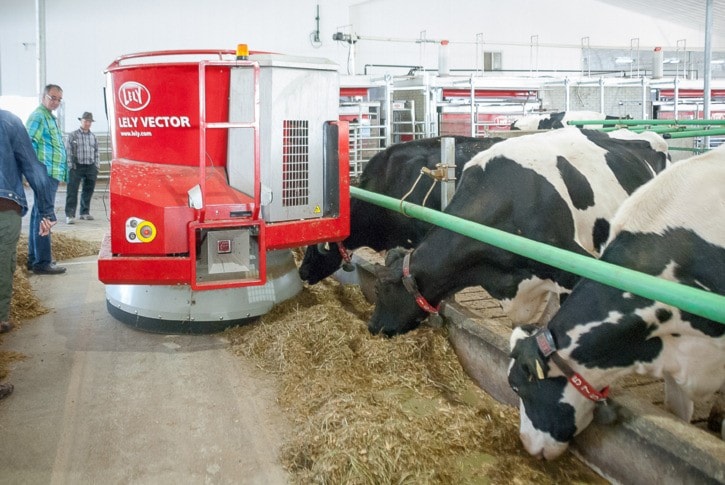Like a phoenix rising from the ashes, the Peter Doornenbal family has built a bigger and more modern barn from the ashes of their dairy farm operation destroyed by fire in June 2014.
“It was about August that we made the decision to rebuild” said Peter Doornenbal on Tuesday, July 7, the day they opened their new facility to visitors. “We replaced our cows by purchasing an existing herd, and then we rented the facilities to continue operating while we completed our new barn.”
“This is now one of the most up-to-date, state-of-the-art dairy barns in Canada,” said David Numan of Penner Farm Services, incorporating the only robot feeder in Alberta.
There are only about a dozen of these feeders across Canada, and they really reduce the farmer’s workload. With a fully stocked kitchen, the robot can take care of feeding the cows for up to a week.
The kitchen is the area of the barn where the farmer will stock the various types of feed. With the use of lasers and cameras, the robot will restock the feeder with specific mixtures of feed.
The feeder continually monitors the feed levels and dispense feed as needed. It also has the ability to provide different feed mixtures to different bunks so the cows are fed a ration that is tailored to their needs.
In addition to the robotic feeder, there are also three robotic milking machines that allow the cows to milk themselves.
A radio collar on the cow identifies the animal to the robot. The robot keeps track the last time that the cow was milked and how much milk was produced.
“Some cows can be milked two times a day, others can be milked up to six times in a day,” said Numan. “So when a cow walks into the milker, the robot determines which cow is there, when it was last milked, and how much milk was produced, to determine if the cow is ready for milking again.
If it isn’t ready for milking, it will move the cow out of the milking stall. If it is ready for milking, then an arm with spinning brushes swings in to wash the teats. Once washed, the teat cups are then moved into position and attached. Once milking begins, the flow from each of the four teats is measured, as well as the total output.
In addition, the milking robot and the radio collar allow the farmer to sort and move cows to other pens, or to isolate them, so that they can be examined by the farmer.
All of this automation allows a single person to manage a 120 cow herd with no assistance, and without being tied to the barn for milking twice a day, said Numan
“Now if the farmer wants to go watch his kids’ school recital or game etc., he can just leave, knowing that the cows will be fed, and milked.”
“With a fully stocked kitchen the farmer can even take a holiday.
Over 500 people came from across the province to the open house of the Doornenbal family’s new state of the art dairy facility.
